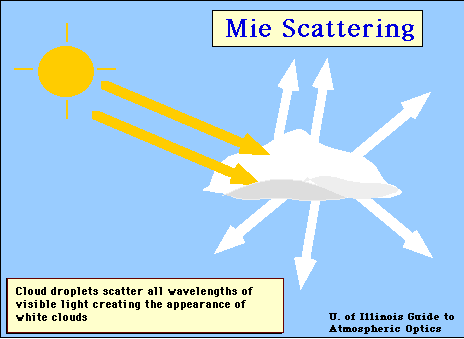
|
Scattering is the process by which "small particles suspended in a medium of a different index of refraction diffuse a portion of the incident radiation in all directions." With scattering, there is no energy transformation, but a change in the spatial distribution of the energy. Scattering, along with absorption, causes attenuation problems with radar and other measuring devices.
In the above graphic by the University of Illinois, sunlight comes into the atmosphere and can be scattered in any direction as it passes through a medium. This diffuses the light-- spreading it out in all directions so it is not just a single, straight beam. If it was not for scattering, we would not be able to see shadowed objects such as walnuts that have fallen on the ground under the shading of a tree. There are three different types of scattering: Rayleigh scattering, Mie scattering, and non-selective scattering. Rayleigh scattering mainly consists of scattering from atmospheric gases. This occurs when the particles causing the scattering are smaller in size than the wavelengths of radiation in contact with them. This type of scattering is therefore wavelength dependent. As the wavelength decreases, the amount of scattering increases. Because of Rayleigh scattering, the sky appears blue, as in the picture below. This is because blue light is scattered around four times as much as red light, and UV light is scattered about 16 times as much as red light.
Mie scattering is caused by pollen, dust, smoke, water droplets, and other particles in the lower portion of the atmosphere. It occurs when the particles causing the scattering are larger than the wavelengths of radiation in contact with them. Mie scattering is responsible for the white appearance of the clouds, as seen below.
The effects are also wavelength dependent. A graphic about mie scattering from the University of Illinois is shown below.
The last type of scattering is non-selective scattering. It occurs in the lower portion of the atmosphere when the particles are much larger than the incident radiation. This type of scattering is not wavelength dependent and is the primary cause of haze. |







